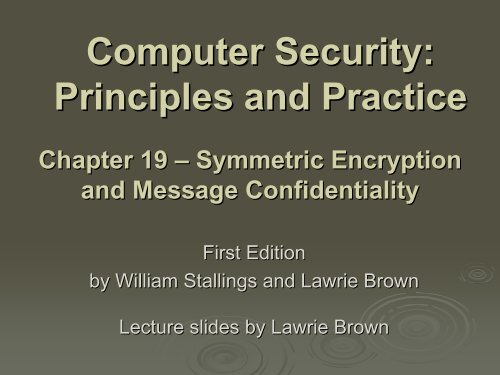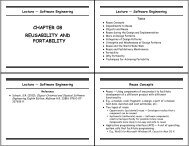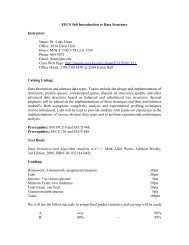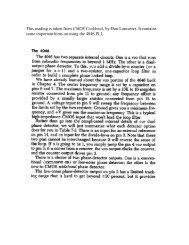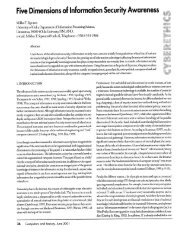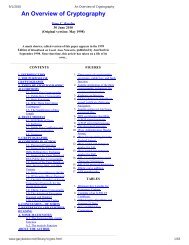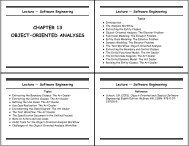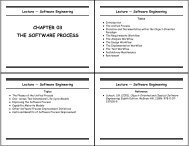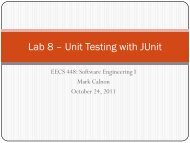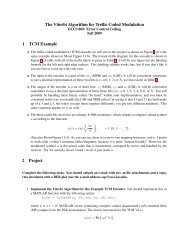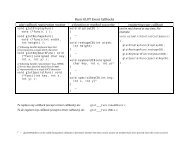Computer Security: Principles and Practice, 1/e
Computer Security: Principles and Practice, 1/e
Computer Security: Principles and Practice, 1/e
- No tags were found...
You also want an ePaper? Increase the reach of your titles
YUMPU automatically turns print PDFs into web optimized ePapers that Google loves.
<strong>Computer</strong> <strong>Security</strong>:<strong>Principles</strong> <strong>and</strong> <strong>Practice</strong>Chapter 19 – Symmetric Encryption<strong>and</strong> Message ConfidentialityFirst Editionby William Stallings <strong>and</strong> Lawrie BrownLecture slides by Lawrie Brown
Symmetric Encryption <strong>and</strong>Message Confidentiality‣ also known as: conventional encryption, secret-key, or single-key encryption• only alternative before public-key crypto in 70’s• still most widely used alternative• has ingredients: plaintext, encryption algorithm, secretkey, ciphertext, , <strong>and</strong> decryption algorithm‣ generically classified along dimensions of:1. type of operations used2. number of keys used3. way in which the plaintext is processed
Computationally Secure Algs‣ encryption is computationally secure if:• cost of breaking cipher exceeds info value• time required to break cipher exceeds theuseful lifetime of the info‣ usually very difficult to estimate theamount of effort required to break‣ can estimate time/cost of a brute-forceattack (see Ch 2)
FeistelCipherStructure
Block Cipher Structure‣ have a general iterative block cipher structure• with a sequence of rounds• with substitutions / permutations controlled by key‣ parameters <strong>and</strong> design features:• block size• key size• number of rounds• subkey generation algorithm• round function• also: fast software en/decrypt, ease of analysis
Data Encryption St<strong>and</strong>ard(DES)
Triple DES (3DES)‣ first used in financial applications‣ in DES FIPS PUB 46-3 3 st<strong>and</strong>ard of 1999‣ uses three keys & three DES executions:C = E(K 3 , D(K 2 , E(K 1 , P)))‣ decryption same with keys reversed‣ use of decryption in second stage givescompatibility with original DES users‣ effective 168-bit key length, slow, secure‣ AES will eventually replace 3DES
AdvancedEncryptionSt<strong>and</strong>ard(AES)
AES Round Structure
Substitute Bytes‣ a simple table lookup in S-boxS• a 16×16 matrix of byte values• mapping old byte to a new value• e.g. {95} maps to {2A}• a permutation of all possible 256 8-bit 8values‣ constructed using finite field properties• designed to be resistant to knowncryptanalytic attacks‣ decrypt uses inverse of S-boxS
Shift Rows‣ on encrypt left rotate each row of State by0,1,2,3 bytes respectively‣ decrypt does reverse‣ to move individual bytes from one columnto another <strong>and</strong> spread bytes over columns
200 INTERNATIONAL JOURNAL OF INTELLIGENT CONTROL AND SYSTEMS, VOL. 10, NO. 3, SEPTEMBER 2005improve this paper significantly. He would also like tothank Dr. Johann Borenstein for his support on this work.Reference1 S. Betgé-Brezetz, P. Hebert, R. Chatila, <strong>and</strong> M. Devy, “Uncertainmap making in natural environments,” Proc. IEEE InternationalConference on Robotics <strong>and</strong> Automation, Minneapolis, MN, 1996,pp. 1048-1053.2 D. S. Apostolopoulos, M. D. Wagner, B. Shamah, L. Pedersen, K.Shillcutt, <strong>and</strong> W. L. Whittaker, “Technology <strong>and</strong> field demonstrationof robotic search for Antarctic meteorites,” International Journal ofRobotics Research, vol. 19, no. 11, pp. 1015-1032, 2000.3 K. Fregene, R. Madhavan, <strong>and</strong> L. E. Parker, “Incremental multi-agentrobotic mapping of outdoor terrain,” Proc. IEEE InternationalConference on Robotics <strong>and</strong> Automation, Washington, DC, 2002, pp.1339-1346.4 R. Simmons, et al., “Experience with rover navigation for lunar-liketerrains,” Proc. IEEE/RSJ International Conference on IntelligentRobots <strong>and</strong> System, Pittsburgh, PA, 1995, pp. 441-446.5 H. Seraji <strong>and</strong> A. Howard, “Behavior-based robot navigation onchallenging terrain: a fuzzy logic approach,” IEEE Trans. on Robotics<strong>and</strong> Automation, vol. 18, no. 3, 2002.6 I. S. Kweon <strong>and</strong> Takeo Kanade, “High-resolution terrain map frommultiple sensor data,” IEEE Trans. on Pattern Analysis <strong>and</strong> MachineIntelligence, vol. 14, no. 2, pp. 278-292, 1992.7 E. Krotkov <strong>and</strong> R. Hoffman, “Terrain mapping for a walkingplanetary rover,” IEEE Trans. on Robotics <strong>and</strong> Automation, vol. 10,no. 6, pp. 728-738, 1994.8 C. M. Shoemaker <strong>and</strong> J. A. Bornstein, “The demo III UGV program:a testbed for autonomous navigation research,” Proc. IEEEISIS/CIRA/ISAS Joint Conference, Gaithersburg, MD, 1998, pp. 644-651.9 C. Ye <strong>and</strong> J. Borenstein, “Obstacle avoidance for the segway roboticmobility platform,” Proc. the American Nuclear Society InternationalConference on Robotics <strong>and</strong> Remote System for HazardousEnvironment, Gainesville, FL, 2004, pp. 107-114.10 C. Ye <strong>and</strong> J. Borenstein, “A novel filter for terrain mapping with laserrangefinders," IEEE Trans. on Robotics, vol. 20, no. 5, pp. 913-921,2004.11 D. Langer, J. K. Rosenblatt, <strong>and</strong> M. Hebert, “A Behavior-basedsystem for off-road navigation,” IEEE Trans. on Robotics <strong>and</strong>Automation, vol. 10, no. 6, pp. 776-783, 199412 D. B. Gennery, "Traversability analysis <strong>and</strong> path planning for aplanetary rover," Autonomous Robots, vol. 6, no. 2, pp. 131-146,1999.13 S. Singh, et al., “Recent progress in local <strong>and</strong> global traversability forplanetary rovers,” Proc. IEEE International Conference on Robotics<strong>and</strong> Automation, San Francisco, CA, 2000, pp. 1194-1200.14 J. A. Janét, R. C. Luo, <strong>and</strong> M. G. Kay, “Autonomous Mobile RobotGlobal Motion Planning <strong>and</strong> Geometric Beacon Collection UsingTraversability Vectors”, IEEE Trans. on Robotics <strong>and</strong> Automation,vol. 13, no. 1, pp. 132-140, 1997.15 N. J. Nilsson, <strong>Principles</strong> of Artificial Intelligence, Tioga PublishingCompany, 1980.16 A. Stentz <strong>and</strong> M. Hebert, “A complete navigation system for goalacquisition in unknown environments,” Autonomous Robots, vol. 2,no. 2, 1995.17 C. Ye <strong>and</strong> D. W. Wang, “A novel navigation method for autonomousmobile robots,” Journal of Intelligent <strong>and</strong> Robotic Systems, vol. 32,no. 4, pp. 361-388, 2001.18 S. Lacroix, et al., “Autonomous Rover Navigation on UnknownTerrains: Functions <strong>and</strong> Integration,” International Journal ofRobotics Research, vol. 21, no. 10-11, pp. 917-942, 2002.19 I. Kammon, E. Rivlin, <strong>and</strong> E. Rimon, “A new range-sensor basedglobally convergent navigation algorithm for mobile robots,” Proc.IEEE International Conference on Robotics <strong>and</strong> Automation,Minneapolis, MN, 1996, pp. 429-435.20 S. L. laubach <strong>and</strong> J. W. Burdick, “An autonomous Sensor-based pathplannerfor planetary micorovers,” Proc. IEEE InternationalConference on Robotics <strong>and</strong> Automation, Detroit, MI, 1999, pp. 347-354.21 H. Haddad, M. Khatib, S. Lacroix, <strong>and</strong> R. Chatila, “Reactivenavigation in outdoor environments using potential fields,” Proc.IEEE International Conference on Robotics <strong>and</strong> Automation, 1998,pp. 1232-1237.22 Y. Koren <strong>and</strong> J. Borenstein, “Potential Field Methods <strong>and</strong> TheirInherent Limitations for Mobile Robot Navigation,” Proc. IEEEInternational Conference on Robotics <strong>and</strong> Automation, Sacramento,CA, 1991, pp. 1398-1404.23 J. Borenstein <strong>and</strong> Y. Koren, “The Vector Field Histogram−FastObstacle-Avoidance for Mobile Robots,” IEEE Trans. on Robotics<strong>and</strong> Automation, vol. 7, no. 3, pp. 278-288, 1991.24 L. Ojeda, M. Raju <strong>and</strong> J. Borenstein, “FLEXnav: A Fuzzy LogicExpert Dead-reckoning System for the Segway RMP.” Proc. of theDefense <strong>and</strong> <strong>Security</strong> Symposium (was Aerosense) UnmannedGround Vehicle Technology VI (OR54), Orl<strong>and</strong>o, FL, 2004.25 D. P. Bertsekas, Constrained Optimization <strong>and</strong> Lagrange MultiplierMethods, Academic Press, 1982.26 D. H. Golub <strong>and</strong> C. F. Van Loan, Matrix Computations, Prentice-Hall, 1986.27 W. H. Press, et al, Numerical Recipes in C++, Cambridge UniversityPress, 2002.Cang Ye received B.E. <strong>and</strong> M.E. degreefrom the University of Science <strong>and</strong>Technology of China, P. R. China in1988 <strong>and</strong> 1991, respectively. He receivedhis Ph.D. degree from the University ofHong Kong in 1999.He is currently an Assistant Professorin Department of Applied Science,University of Arkansas at Little Rock,AR. He was a research investigator atUniversity of Michigan, Ann Arbor, MIfrom 2003 to 2005. His research interests are in mobile robotterrain mapping <strong>and</strong> navigation, fuzzy systems <strong>and</strong> reinforcementlearning.Dr. Ye is a senior member of IEEE <strong>and</strong> a member of TechnicalCommittee on Robotics <strong>and</strong> Manufacturing Automation, IEEESystems, Man, <strong>and</strong> Cybernetics Society.
Stream Ciphers‣ processes input elements continuously‣ key input to a pseudor<strong>and</strong>om bit generator• produces stream of r<strong>and</strong>om like numbers• unpredictable without knowing input key• XOR keystream output with plaintext bytes‣ are faster <strong>and</strong> use far less code‣ design considerations:• encryption sequence should have a large period• keystream approximates r<strong>and</strong>om number properties• uses a sufficiently long key
RC4
Modes of Operation‣ block ciphers process data in blocks• e.g. 64-bits (DES, 3DES) or 128-bits (AES)‣ for longer messages must break up• <strong>and</strong> possibly pad end to blocksize multiple‣ have 5 five modes of operation for this• defined in NIST SP 800-38A• modes are: ECB, CBC, CFB, OFB, CTR
Electronic Codebook (ECB)‣ simplest mode‣ split plaintext into blocks‣ encrypt each block using the same key‣ “codebook” because have uniqueciphertext value for each plaintext block• not secure for long messages since repeatedplaintext is seen in repeated ciphertext
Cipher Block Chaining (CBC)
Cipher Feedback (CFB)
Counter (CTR)
Location of Encryption
Key Distribution‣ symmetric crypto needs a shared key:‣ two parties A & B can achieve this by:• A selects key, physically delivers to B• 3rd party select keys, physically delivers to A, B• reasonable for link crypto, bad for large no’s s users• A selects new key, sends encrypted usingprevious old key to B• good for either, but security fails if any key discovered• 3rd party C selects key, sends encrypted toeach of A & B using existing key with each• best for end-toto-end encryption
Key Distribution
Summary‣ introduced symmetric encryption basics‣ DES, 3DES <strong>and</strong> AES‣ stream ciphers <strong>and</strong> RC4‣ modes of operation‣ location of encryption‣ key distribution


